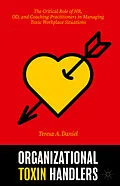This book examines the important role of HR practitioners acting as toxin handlers within their organizations and the dangers they face when dealing with toxic workplace emotions caused by difficult organizational decisions, such as mergers and acquisitions, reductions in force, restructurings, and the like. Exploring what they do, why they do it, and the personal and professional rewards created by the work, it also examines the dangers that await them in terms of risks to their personal well-being.
Autorentext
Teresa A. Daniel currently serves as Dean and Professor of the Human Resource Leadership Programs at Sullivan University, USA. She is also the Chair for the HRL concentration in the university's PhD in Management program.
Dr. Daniel has a significant body of research in HR with an emphasis on two primary areas of inquiry: (1) counterproductive work behaviors (focused on workplace bullying, sexual harassment, and toxic leadership), and (2) HR's unique role and its impact on organizational effectiveness (e.g., in the management of toxic workplace emotions, responding to situations of workplace bullying and harassment, dealing with toxic leaders, and the management of people during mergers and acquisitions). Her research has been actively supported by the national Society for Human Resource Management (SHRM) through the publication of numerous articles and interviews, as well as by the publication of her book, co-authored with Dr. Gary Metcalf, titled Stop Bullying at Work: Strategies and Tools for HR, Legal & Risk Management Professionals.
Dr. Daniel was honored as an Initial Fellow of the International Academy on Workplace Bullying, Mobbing, and Abuse in 2014 and received the Distinguished Alumnus Award at Centre College in 2002. Most recently, she was the 2019 Grand Prize Winner of the national SHRM HR Haiku contest.
Inhalt
1 Toxin Handlers: Who They Are and What They Do
2 What Causes Toxic Workplace Situations? A Focus on the Economic and Legal Drivers
3 What Causes Toxic Workplace Situations? A Focus on the Individual, Situational, and Systemic Drivers
4 What Causes Toxic Workplace Situations? A Focus on the Ethical Drivers
5 Why They Do It6 How They Reduce Organizational Pain
7 Why Organizations Need Them
8 Friend or Assassin: Whose Side Is HR On, Anyway?
9 The Price They Pay
10 Running on Empty: Warning Signs of Compassion Fatigue and Burnout11 Perceived Low Value of HR's Work to Senior Leaders (and How HR Can Fix This)
12 Promising Macro Strategies to Minimize Harm to Toxin Handlers
13 Promising Micro Strategies to Minimize Harm to Toxin Handlers
14 Can We Reduce Organizational Toxicity by Improving Our Leaders? Hint: Yes, We Can!
15 The So-What? Making Sense of It All
16 Epilogue: A Manifesto for a New (and Better) Future
Correction to: The So-What? Making Sense of It All
Appendix A: Executive Summary of the Research Study
Appendix B: Technical Report
Bibliography
Index
